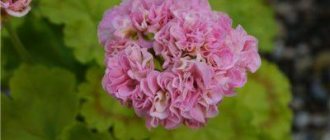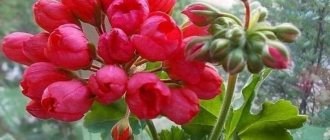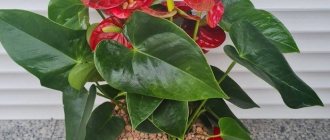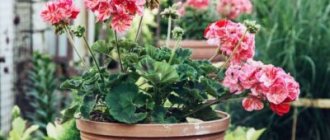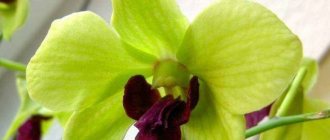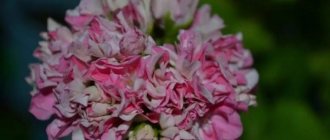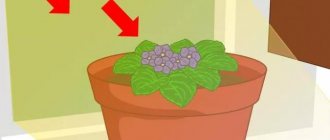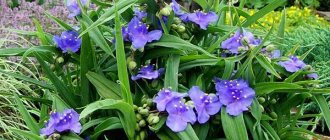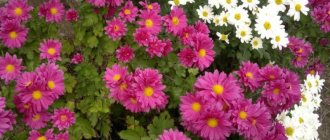“Damascus” roses belong to the class of old garden varieties of the crop and constitute a whole group of diverse varieties, which includes both old Persian-Turkish representatives and modern European hybrids. They have been cultivated since ancient times, have a rich history and are included in the UNESCO list of intangible heritage.
Damask roses are famous for their amazingly beautiful lush flowers, wide palette of colors and extraordinary fragrant aroma
Damask roses are among the most fragrant. Since ancient times, they were grown primarily to obtain valuable rose oil, famous for its healing and perfume properties. Based on it, rose water was prepared, which was very popular for many centuries. There is an opinion that it is precisely thanks to the high content of essential oils of exceptional quality that these roses have not disappeared to this day and continue to be popular in many countries of the world, primarily in the Middle East.
Kazanlak is considered one of the most fragrant Damask varieties. It is grown commercially as an essential oil crop in Bulgaria, as well as Turkey, Iran, India and Morocco, where rose oil is produced from the petals.
History of origin
Initially, India was considered the birthplace of pelargonium, but this statement was erroneous. And all because it was delivered on European ships that sailed to the shores of India. As it turns out, South Africa is the true place where pelargonium grows . There, at the Cape of Good Hope, sailors bought exotic plants for breeders and botanists. 80% of the known pelargonium species were found in this part of the world.
In 1951, an association of amateurs and breeders called the British Pelargonium and Geranium Society was created in England, under the leadership of John Cross. Thanks to this, a new wave of popularity for pelargoniums began, and interest in marvelous flowers was revived, which continues today.
Reference. More than 100 million plants are grown and sold worldwide each year.
Appearance and varieties
Pelargonium is a perennial herbaceous or subshrub plant. The inflorescences have an irregular shape. Petals are white, pink, and shades of red.
The fruit is a seed capsule with sepals. The foliage is green, covered with small fibers. The leaves have a pleasant smell.
Experts in the field of botany count over 250 varieties of pelargonium, which are divided into 30 groups. Main groups :
- zonal;
- ivy-leaved;
- fragrant;
- royal;
- angels;
- unique.
Greenhouse farms in Great Britain, Belgium, Holland, and Russia are engaged in the selection of pelargonium. I would like to highlight the domestic amateur breeder Yulia Gonchar. She has the following varieties :
- Pelargonium South-Aksinya.
- South Alexandra.
- South Anisa.
- South-Giselle.
- South Yesenia.
- South Deya.
- South-Tamil.
- South Ireland.
- South Siberia.
- Yug-Eter and others.
Main characteristics
Let's look at the key features of Damask roses in the table:
| Parameter | Characteristic |
| Family | Roses (Rosaceae)/Rosaceae |
| Genus | Rosehip (Rosa) |
| View | Damask rose (Rósa×damascena)/Damask (D) |
| Garden group | Old Garden Roses |
| Form | Bush |
| Life cycle | perennial |
| Purpose | Industrial, decorative |
| Dimensions of the bush (height / width) | 80-200 cm / 50-120 cm |
| Flowering type | Single (some varieties are re-blooming) |
| Flowering period | June – July (certain varieties – until late autumn) |
| Type of flower | Semi- and dense double |
| Number of petals | 25-40 pcs. |
| Flower diameter | 6-10 cm |
| Petal coloring | Varied: from white-pink to red |
| Disease resistance | Average |
| Frost resistance | Up to −17… −20 ℃ |
Description and photos of species of Yu. Gonchar’s own selection
Below is a detailed description and photo of the varieties Shukar, Varvara Krasa, Nina, Kamalia.
Nina
Plants of the species are zonal, dwarf in size . Flowers with densely double petals, pale pink with a soft purple tint. A lush compact bush easily forms on its own. The stem and peduncles are dense, fleshy, directed upward. The inflorescences are shaped like roses. The foliage color is golden with a brown edge.
This variety of pelargonium got its name in honor of grandmother Yulia Gonchar. The price of a rooted cutting is 1000-1500 rubles.
Shukar
This species also belongs to the zonal species. Standard size, requires shaping. Inflorescences are scattered in different directions. Shades: cherry, scarlet, dark red with tints. The texture of the flowers is semi-double and simple, large in size. The shape of the petals is slightly elongated. The name "Shukar" translated from the Gypsy language means "beauty" . The price of a rooted cutting varies from 1000-1200 rubles.
Varvara Krasa
An upright zonal plant, dwarf in size. The bush is dense, dense, easy to form, and has regular growth. The flowers are large, double, light pink. In the sun it takes on a deeper pink hue. Pelargonium blooms profusely and for a long time. You can buy rooted cuttings for 500-700 rubles apiece.
Kamalia
Zonal flower, dwarf size. The bush is branched, the foliage is green. The inflorescences have an original shape, slightly shabby. The color is soft pink, gradually turning to rich. The texture of the flowers is terry. The variety is distinguished by long-lasting flowering, even in winter. The cost of one cutting is 700-1000 rubles.
Rose scent
The main aroma of ROSE oil is smoky, low, bluesy, honey, tart.
- Shades of tonality (complex aroma that has an additional tone - the tone of heat): upper - melted beeswax; medium - tart, floral; heat tone - dry, smoky; the bottom one is transparent, light, caramel.
- The aroma of luxury that hovers around the aristocracy and bohemia. Enriches emotions, gives them complex, subtle accents.
- An antidote to feelings of resentment, because it takes everything external beyond the circle of personal consciousness. Helps ardent people to calmly resist the irony and causticism of others, without perceiving it as a provocation. Eliminates inferiority complex.
- Develops the talent to laugh at oneself easily and cheerfully. Eliminates symptoms of fatigue, relieves reactions to stress, and increases performance. Stimulates creative and intellectual growth, eliminates the constraint of the imagination.
- Facilitates the process of going to bed and waking up, harmonizes biological rhythms. Creates a cozy and joyful atmosphere in the house, neutralizing the effects of the most disgusting weather outside the windows.
Rose essential oil is one of the most powerful aphrodisiacs with legendary status. It is considered ideal for modest and insecure partners; it enhances trepidation and sensuality.
Rose essential oil goes well with the aromas of spruce, bergamot, bitter orange, ginger, lavender, palmarosa, vetiver, jasmine, clove, lemon balm, cinnamon, cedar, ylang-ylang, black pepper, patchouli, myrrh, nutmeg, myrtle.
How and where to plant?
The container for pelargonium is chosen to have a small diameter. Compact flower bushes will hold their shape better in them; flowering also directly depends on the size of the flowerpot . The plant refuses to bloom in large pots. Material for the container, preferably clay. A drainage layer of at least 2 cm thick is required.
- The plant should be placed in a pot carefully; the root system is fragile.
- Then carefully sprinkle it with earth without compacting it.
- Moisten the top a little with warm, settled water.
Lighting
You need a lot of light. The plant loves sun and bright light. Preference should be given to window sills on the south side. However, if there is poor ventilation, it may overheat, in which case you need to temporarily darken it. With a lack of sunlight, the leaves turn yellow and the lower ones dry out. For an evenly lush crown, the flower must be regularly turned to the sun, first on one side, then on the other.
The soil
For planting and replanting, the soil needs to be loose, breathable, and enriched with minerals. Soil for pelargonium can be purchased ready-made at garden stores . Or cook it yourself.
The composition of this soil mixture is: leaf soil, peat or compost humus, sand. All components must be in equal proportions.
For safety precautions, it is better to ignite the components of the mixture for 30 minutes. You can also add perlite as a soil loosener.
Interesting Facts
- To obtain 1 g of rose oil, you need to process about 2000 rose flowers.
- One rose bush produces 15 - 20 kilograms of flowers per season, from which about 7.5 liters of high quality rose water can be produced
- In roses, the gene responsible for the aroma is recessive. This means that crossing two varieties with an intense aroma will result in a hybrid with less fragrant flowers.
- In the “History of the Augustans” - a collection of biographies of Roman emperors (a historiographical monument of the 4th century), there is a story about Emperor Heliogabalus from the Severan dynasty, who ruled the Roman Empire from 218 to 222. One day, wanting to get rid of his enemies, he invited them to a feast. The arriving “guests” were sprinkled with so many rose petals that they suffocated.
- When the Arabs captured Jerusalem in 1187, the Egyptian Sultan Saladin turned all the Christian churches in the city, except the Temple of the Resurrection, into mosques, ordering them to be cleaned beforehand - washed with rose water brought from Damascus. The Turkish Sultan Mehmed II Fatih did the same in 1453 with the main Byzantine temple of Hagia Sophia when he captured Constantinople. (In 1935 this temple became a museum).
- Damask rose essential oil has long been used in the creation of perfumes, but its smell is different from the aroma of natural flowers. Rose oil is heavier, thicker and more concentrated. Experts describe it as luxurious, intoxicating, with fruity and woody notes, sometimes with hints of tobacco. In the finished perfume, the aroma of rose oil appears in a diluted form, acquiring new colors.
- Interestingly, rose oil can enhance and emphasize the sound of other flowers in the “pyramid” of a perfume composition, for example, iris, hyacinth, hawthorn and gardenia.
- Damask rose essential oil is successfully used in aromatherapy. Abu Ali Ibn Sina (980 – 1035), a medieval Persian scientist, philosopher and physician from Bukhara, known in Europe as Avicenna, wrote about the healing properties of rose water, prepared from rose petals and pure water under the influence of sunlight. At the beginning of the twentieth century, the Russian scientist N.A. Kuntzel advised using the scent of roses in the treatment of diseases of the nervous system.
- Psychiatrists have long used a test called the “rose test”: a drop of rose oil is applied to the patient’s wrist, and then, after 30 minutes, they check how much its aroma has changed. If a strong sourness appeared in it, it means that the person is suffering from hysteria. For overly romantic individuals, the rose became candied. When the aroma became tart, with notes of tea, this indicated the subject’s strong character and healthy psyche.
- With the participation of specialists from Bulgaria, attempts are being made to grow oil roses in Afghanistan as a cost-effective alternative to opium poppy.
Conditions for growing indoor flowers
Pelargonium is an undemanding indoor flower . However, for a healthy and beautiful appearance, comfortable conditions are important for the plant.
- An indoor flower should be watered abundantly, but at the same time the water should not stagnate in the pot. Watering is needed abundantly, daily, especially in hot weather. In winter, you don’t need to water much, but you should not let the soil dry out completely. If watering is abundant, traces of gray rot appear on the leaves, and sometimes the stem rots, which can lead to the loss of the plant. If you water little, the flower withers, the leaves begin to turn yellow and dry out.
- Air humidity is not particularly important for pelargonium; on the contrary, excess moisture and stagnant air can cause fungal diseases of the flower. Spraying should not be done.
- In the warm season, the optimal temperature is +18 -22 C°. Sufficiently high air temperatures, especially indoors, will also negatively affect the plant.
- In winter, pelargonium is in a state of sleep. Plants should be moved to a room with a temperature of +12°C and regular ventilation. This could be a loggia, balcony, greenhouse. Watering should be sparse. Wintering lasts approximately from November to February. At the end of winter, pelargonium begins to gradually wake up.
- Replanting and pruning. These procedures should be performed annually, preferably in the spring, in mid-March. In order for the plant to have a lush appearance, it is necessary to trim the pieces. Perform this procedure only with a sharp knife diagonally. Broken parts of the plant may be affected by rot. And to enhance growth and branching, shoots are pinched.
- To ensure adequate nutrition, the flower needs to be fed and organic fertilizers applied. But it is important to dose the fertilizer and follow all the instructions indicated on the packaging:
- Feed “Mr. Color” Saintpaulia during or before flowering with 1 capful per 1 liter of water.
- "Gilea" - recommended concentration is 2 caps per 1 liter.
- “Fertimix” vermicompost for flowering plants, 3 caps per 1 liter, apply once every 10-14 days.
Important. Use only clean water at room temperature.
Adding nutrients is prohibited in hot weather. In this case, the plant will suffer stress.
- First, you should move it to a cool place.
- Next, be sure to water the flower, otherwise fertilizers may burn the roots.
Most of all, the plant needs additional nutrition in summer and spring. Therefore, you need to feed until the beginning of September, approximately once every 2 weeks . You should not feed a transplanted or just purchased plant; you need to wait at least 1 month. It is also not recommended to use mineral fertilizers for sick flowers with damaged root systems.
Reviews from gardeners
Svetlana, 62 years old, Sochi
I grow York and Lancaster roses. Healthy and strong variety. Grows in partial shade. The bush is wide, the branches require garter. It blooms with beautiful white-pink flowers, the scent permeates the entire area. We look forward to its flowering every year, like a holiday.
Tatyana, 50 years old, Moscow
My Kazanlik variety winters in the Moscow region without shelter. Grows along the path. It blooms very profusely and smells wonderful.
Natalya, 43 years old, Crimea
My Kazanlak rose grows in partial shade. In 3 years, a tall, spreading bush grew. It blooms profusely, but only once. Quite prickly and erect. The flowers are small but very fragrant. But in humid weather it is affected by powdery mildew.
Elena, 40 years old, Moscow
The Madame Hardy variety overwinters without problems under the cover of burlap and film. In winter without snow, even the immature tips did not freeze. It blooms luxuriantly and the aroma develops more in the evening. Does not require special care. Overall I'm very pleased with it.
Reproduction methods
Cuttings
At the end of flowering, the tops of the pelargonium are cut off. The top 3 leaves are left, the others are removed.- Sections must be treated with fungicide, ash or activated carbon. This is done so that the stem of the mother plant does not rot.
- Then the cuttings are placed in transparent glasses with drainage, coke fiber or coarse sand is placed in them, and liquid is poured in.
Another option is to place the cuttings in a container with water and, as they dry, it needs to be added.
Roots appear quite quickly, after 10-12 days . The temperature in the room must be maintained at least +20°C. After this, the rooted cuttings are planted in previously prepared soil in a permanent place, where they continue to develop.
Next, you can watch a video that talks about cuttings:
Dividing the bush
If the bush has grown, you can divide it. The best time for this is spring, when the plant is replanted and the soil is renewed.
- First of all, remove the flower from the pot and shake off excess soil.
- Then they carefully examine his kidneys.
- The area with healthy kidneys is separated and transplanted into another container.
Origin
The ornamental garden plant Rosa Damascena has been grown in the Middle East since ancient times. There is also information about its cultivation in the Roman Empire - frescoes with images of the flower have survived to this day. Then the Arab countries became the main place of distribution. According to official data, the plant was reintroduced to Europe in 1875 from Syria. Disputes about the real homeland of this beautiful flower continue to this day.
Damask roses are harvested at the full bloom stage; their petals are a valuable raw material for the production of rose oil.
Previously it was assumed that the flower is a hybrid of Rosa gallica and Rosa canina. Later, DNA analysis of four ancient Damascus varieties showed that they had a common ancestor of hybrid origin, the parent species of which were: (Rosa moschata × Rosa gallica) × Rosa fedschenkoana.
At the moment, there are many varieties of Damask beauty. The most popular varieties: “Kazanlak” (aka Bulgarian or Turkish rose), “Leda”, “Ispahan”, “Marie Hardy”, “Marie Louise”, “Yolanda de Aragon”, “Perpetual White Moss”, “York and Lancaster” ", "Duc de Cambridge", "Quattro Season" and others.
The photo shows a Damask rose of the Duke de Cambridge variety, which is characterized by long flowering and hardiness.
Diseases and harmful insects
Pelargonium is resistant to various diseases and pests . But they still occur:
- Gray mold is a disease that affects leaves. You need to fight it in the following way: remove damaged leaves, stop watering the plant, put it in the sun, spray it with an antifungal agent.
- Rot of the root collar of a flower develops with excess moisture. This phenomenon turns out to be detrimental to pelargonium.
- Rust appears as yellow spots on the bottom of the leaf.
Disease prevention is to treat plants with antifungal solutions before wintering. They are also sprayed with fungicide products, the drug “Doctor Foley” for fungi. The affected parts of the plant must be removed. Among insects, the main pests are whiteflies, aphids, mites, thrips, and mealybugs.
Advice. Before buying a flower, carefully inspect it; you can infect other healthy plants. They are treated with products with insectoacaricidal properties, for example “Doctor Foley” against parasites.
What other famous varieties of pelargonium are there? Read about Richard Hudson, Prince Gustav, April Snow, Star-shaped, Milfeed Rose, Australian Pink Rosebud, Anita, Rococo, Grandiflora, Red Pandora.
Growing pelargonium at home is not at all difficult . Especially if you follow the basic rules for caring for the plant. Then the flower will grow and smell fragrant for joy.
